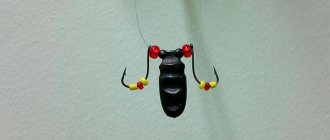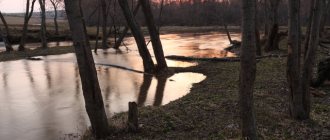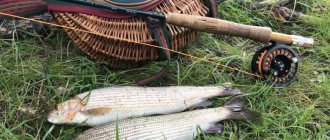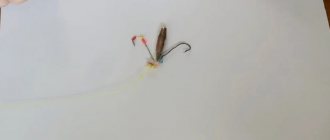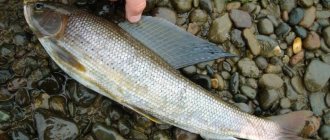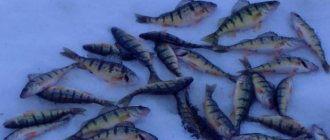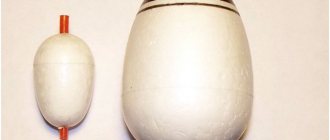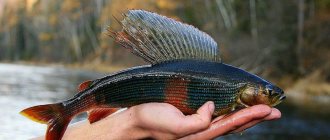Peculiarities of catching grayling on a bulldozer
Fishermen have been using the bait, which has the very ambiguous name “bulda,” for a long time. This tackle gives good fishing results both in winter and summer. In the district of the Yamalo-Nenets Autonomous Region, since time immemorial, there has been such a float rig, where several leashes with artificial flies are attached to the main line slightly above the float. In the Komi Republic, when hunting grayling, they used similar equipment, which made it possible to cast without overlap over very long distances. This kind of tackle is called “balda” or “yalda”, although other local names are possible.
Running donka. Device
A running donka can be a completely homemade tackle. Starting from the rod and reel, right down to the float, sinker and flies. Such gear was manufactured at numerous military factories - these were titanium or duralumin blanks and homemade inertial reels on bearings.
Now almost all components of this equipment can be purchased in stores. However, many anglers make their own floats and sinkers, not to mention homemade fishing flies.
A modern running donka (balda) includes:
- the actual spinning rod (blank) with a test weight of 40-80, quite rigid, plug-in or telescopic, from 2.5 to 4.5 meters long, with rings of increased diameter;
- inertial coil on bearings, with a diameter of 120-180 mm, or an inertia-free coil, class 2500 and higher;
- monofilament line 0.3-0.5 mm, or braided line, 100-200 m long;
- movable limiter - float stopper;
- large foam float with beads;
- top swivel;
- leash (post, setup), 1.0-1.5 m long, only made of mono fishing line with knots or loops for attaching 2-3 flies;
- lower swivel with clasp or winding ring;
- streamlined sinker - homemade from lead or other metal weighing from 30 to 90 g.
When fishing with braided fishing line, problems arise with the limiter, which are solved by installing a shock leader made of monofilament 20 meters long.
How to choose a bullhead for grayling fishing
Nowadays, grayling fishing has become popular everywhere. This simple gear is in the arsenal of most “silent hunting” lovers. When choosing a float, you need to understand that it is essentially a self-submersing float weighing up to 100 g and up to 12 cm long. It can be made of wood or dense foam. A lead weight weighing up to 50% of the entire float load is attached to the bottom. In the center of the float there is an inclined hole through which the fishing line is passed and tied to the ring. On a two-meter spinning rod you need to use 2 leashes (one 10 cm long and the other 15 cm long). They must be 20 and 50 cm away from the bulldozer. The main line must have two stoppers made of beads, and between them there is a fixed button with holes for the line and leash. Leashes can be equipped with a variety of flies.
Depending on the time, place and fishing conditions, you can choose from three varieties of bullhead that are common in our country. Firstly, this is a classic bulldozer used in winter. This is a drop-shaped weight with a loop of fishing line on which a pair of hooks with beads are fixed. On the rivers of Siberia, you can use a classic bulldozer with a so-called post (or setup), that is, a piece of fishing line with several leashes. And another variety is a large float of a composite structure (wooden or foam top and lead bottom). This device is convenient to use when fishing for grayling on the surface.
When fishing for grayling on a bulldozer, sinkers of various configurations are used. They can be either pear-shaped or elongated. A thin and elongated sinker has a certain advantage. The fact is that it can easily be adjusted to a float in specific conditions. This is done with the help of wire cutters, which can be used to reduce it to the desired weight right while fishing.
How to make a bulldozer for grayling yourself?
How to make a bulldozer for catching grayling, and what is needed for this? I'm also wondering if there are any special requirements for the shape of the float.
This type of gear has several mounting variations and works great for a huge number of predatory fish, including salmon species. In technical terms, making a fishing rod for grayling is quite simple, but requires compliance with the weight proportions between the sinker and the float, as well as careful selection of the rod, reel, and the thickness of the leader and main fishing line. To simplify the task as much as possible, we will immediately indicate the optimal parameters of the equipment, which demonstrates consistently high catchability on rivers with moderate and fast currents with any type of gravel, rocky or boulder bottom.
The correct setup of a blank for grayling fishing requires the use of medium or slow action rods with a test load of 70-100 g. For fishing from a boat, a blank 2.4-2.4 m long is enough, from the shore - 2.5-3.6 m. Classic installation of the tackle provides for an inertial reel of 130-150 mm, which provides the best control of the bait as it drifts downstream. An inertia-free “meat grinder” (3000-4000) also copes well with this task, if after the request you do not throw the line handle, but slowly release the thread with your fingers. In addition, it remains possible to deliver bait as far and accurately as possible and conveniently switch to another type of equipment and bait.
The correct production of a bulldozer for catching grayling is not complete without a stick-shaped lead sinker (25-30 g), which can be replaced with a “Tirol” of similar weight. In this case, a float with a carrying capacity 1.5 times greater (45-50 g) is selected. Drop-shaped models with thickening at the bottom are optimal. Such bite alarms in a lying position have minimal contact with the surface of the water, which contributes to more controlled and easy presentation of the bait.
To learn more:
Methods of catching asp: fishing time and equipment
To make a balda for catching grayling, you will also need 2-4 small jigs, flies, streamers or hooks with colored beads imitating a larva or insect. During installation, 10-12 cm of lead fishing line 0.25-0.3 mm thick with a loop at the end is tied to the baits. It is important that the jig does not sag, but is well cushioned on the thread. If this does not happen, you need to choose a lighter bait.
During the final setup of the bulldozer for catching grayling, 100-120 cm of monofilament with a diameter of 0.3-0.35 mm is tied to the sinker, which will later be attached to a loop or swivel on the main thread. Leashes with jigs are attached to the equipment, which, depending on the number of baits, are spaced apart at a distance of 15-30 cm. A rubber stopper, a through float for grayling and another limiter are alternately put on the main fishing line with a thickness of 0.4-0.45 mm , which will allow you to save the upper part of the tackle if it breaks. Then a mounting loop is formed or a swivel is tied to which the equipment with bait is attached.
You may also find useful information on how to make a float for a bulldozer yourself. You will need a block of polystyrene foam 85-90 mm long and 60-70 mm wide. A round impression is made at each end of the workpiece using an aerosol cap with a diameter of 45-50 mm. You can use a knitting needle to make a through hole. The initial cylinder is formed with a utility knife; there is no need to cut off more material than the print border allows.
The final processing of the float for grayling, giving it the outline of an egg, is done with medium and then fine sandpaper. A tube from a used ballpoint pen refill is glued inside the mounting hole, which will prevent the line from cutting into and locking in the polystyrene foam. For color painting of surfaces, fluorescent acrylic paint, which is sold in small jars or tubes, is optimal.
To learn more:
Ice fishing for perch on Baldu
Grayling fishing technique
The technique of catching grayling on a bulldozer is not complicated, but it requires fairly good physical preparation. Let's consider its features. The first requirement: the tackle must be cast as far as possible from the shore and upstream, the sound of the float splashing down must be quiet. To achieve this immediately, the weight of the sinker on the leash must be proportional to the casting distance. The current will carry the bulldozer down 100 meters, after which we begin to pull it back. It will slowly move along the bottom, raising mud, and the flies on the leashes will move. This is what attracts fish. Please note that the equipment should under no circumstances be twisted or overlapped with the main line. After casting the bait with a fishing rod, this tackle should stand vertically. Maintain this position under all conditions, regardless of the strength of the current and the length of the stretched fishing line. Verticality will ensure uniform and symmetrical vibrations of the hooks. Namely, these movements, similar to the movements of various aquatic life that rush to the surface, work for the catch. By tapping the bottom with the tackle, it is advisable to raise silt or sand. In such turbidity, grayling will definitely mistake the moving bait for live food.
How the tackle works
Bottom tackle for catching grayling has several varieties. In accordance with the design features there are:
1. Classic bulldozer.
Its design is extremely simple. The tackle consists of a drop-shaped weight. In its upper part there is a hole through which a loop of monofilament is threaded. Two hooks are attached to the loop, directed in different directions from the load. Hooks are decorated with colored beads, cambrics, and threads. When fishing for grayling, be sure to put live bait or an artificial fly on the hook: even inactive fish will bite on it.
The classic bulldozer works well in the cold season
The tackle is effective on rivers with a sandy or muddy bottom, so grayling is caught with it mainly in autumn or winter, when the fish move from the rapids into deep holes. In summer, grayling can be caught in deep rivers (Yenisei) and Siberian lakes using the classic bullhead.
In the hunt for grayling, the traditional running donka is rarely used, giving preference to the more catchy Siberian balda.
2. Siberian Balda, or “cargo mood”.
The Siberian balda for grayling differs from the classic version in a more complex design, which allows you to catch the most promising fish habitats: riffles, rapids, points above and below rapids. Fishing tackle includes:
- a load weighing 40–80 g in the form of a bullet or drop. Advice! The higher the flow speed, the heavier the load should be;
- setup (another name is a column): a piece of fishing line 0.5–1 m long with 2–4 leashes. Hooks with flies or other attachments are attached to leashes;
- float or boom: a large loaded float that allows you to move the tackle with the current and signal a bite. Important information! The buoyancy force of the float should be 1.5 times the weight of the load.
The Siberian balda differs from the classics not only in design, but also in catchability
Fishing for grayling using a Siberian trout is effective in midsummer, when the fish stays in the lower layer of water. A heavy load in the process of tapping the bottom raises a cloud of turbidity, attracting grayling. The Angara and its tributaries are the most promising bodies of water for using gear.
3.Higher spirit.
One of the variants of the Siberian bully for grayling. The riding setup differs from the previous equipment in that it is used at the surface of the water.
The main element of the riding spirit is a massive float, the body of which consists of two parts. The top is made of wood or other floating material, the bottom is weighted with lead.
Advice! When choosing a float shape, it is better to choose a bullet or a drop. In a lying position, such a rod has minimal contact with the surface of the water. This makes retrieving easier and allows you to more successfully control the bait.
A rig consisting of two leashes of different lengths with hooks is attached directly to the float.
The riding attitude is especially effective in the spring, when grayling grabs falling insects from the surface of the reservoir.
Advice! It is necessary to ensure that the bait does not sink. To do this, baits must be light (for example, a dry fly).
Properly made and mounted tackle and bait selected in accordance with the season and characteristics of the reservoir are a guarantee of a good catch.
Fishing for grayling on balda in summer and winter
They catch grayling on the bait both in summer and in winter. But, according to many, winter fishing is more catchy, although summer fishing is also successful. Summer fishing for grayling on baldu begins after spawning. Usually a fishing rod is used, the length of which is about 6 m. It is impossible to say exactly the length of the fishing rod, since it all depends on the width of the river. Experienced fishermen advise removing the tulip from the rod, in which case unrealized bites will be minimized. The fact is that the soft tip cannot hold the fish, and most of the fish will go away. The boom itself should be quite heavy in order to attract grayling by knocking on the bottom. You can fish with this bait in the summer both from the shore and from a boat. If you are fishing using a watercraft, the process will be carried out vertically. Lower the bait to the bottom, raising the turbidity, then the fish will definitely be interested in it. In winter, it is best to catch grayling on a balda during the first ice period, when the fish are hungry and take any bait, although later in large flowing reservoirs you can also successfully use it. When using a balda, you do not need to constantly clean the hole, because crushed ice will not interfere with vertical wiring. And thanks to this, you can successfully catch grayling even in the shallows.
Winter is the season for experimenting with the size of the sinker and the color of the beads on the hooks. When fishing, you can use pieces of silicone, artificial bloodworms, some even use a jig. With all this, we must not forget about the periodic renewal of bait, which must be placed in the hole. Then the fish will not leave the feeder and will continue to actively bite on the bulldozer.
Fishing gear
about the origin of this name for the bait - balda. Some say that this is due to the large float, while others attribute it to the sinker, which taps the bottom like a bulldozer. Basically, it doesn't matter. You can associate this name with the assembled gear, or you can also associate it with the method of fishing.
It is better to choose a spinning rod, medium action, with a weight of at least 50–60 grams. Expensive plug rods are absolutely not needed here; you can limit yourself to inexpensive Chinese composite telescopes. The length of the rod is selected depending on the fishing method: from a boat or from the shore.
In the first case, 2.1-2.4 meters is optimal , and in the second, 2.4-3.6 meters. It is better to use rings with a larger diameter, since the stopper will fly through them. Very often, fishermen change the rings themselves, improving the characteristics of the gear.
The choice of coil is important. Fishing with a bulldozer involves releasing the bait downstream while maintaining complete control over it. And this can only be done with inertia-free or multiplier coils. But the majority uses inertia-free ones - their choice is absolutely clear, why pay more? True, handling spinning reels requires certain skills, but everything comes with experience. Even masters of balda fishing experience “beards” when casting.
The diameter of the reel should be in the range of 130–150 mm , a good stopper and ratchet are desirable, as well as the presence of rolling bearings. The manufacturer is not important. They fish with branded, Chinese and already rare famous Soviet Nevskaya reels. The reel assembly with the rod should lie comfortably in your hand, and your thumb should have easy access to its side for braking.
The main line is used 0.35-0.4 mm, and the equipment itself is one step smaller than 0.25-0.3 mm. Leashes 15-20 cm long made of 0.15-0.2 mm fishing line . Sinkers are used in different shapes: pear-shaped, elongated.
Thin and elongated sinkers have the advantage that they are easy to adjust to the float and specific fishing conditions. To do this, use wire cutters to simply reduce it to the required weight while fishing.
Homemade flies of predominantly brown, white or gray tones are used as bait. But they use both red and green.
In the matter of making and choosing the right bait, the fisherman is given a unique opportunity to fully express his creative energy. In regions where grayling is caught, a lazy fisherman can easily buy flies in fishing stores.
Interested in pickerel fishing? Our article will tell you and show you more about this.
In this article you will learn how to catch carp using a fishing rod.
Where to catch grayling on bulldozer
At all times, the main thing for a fisherman was to find active prey. Large and small rivers, flowing reservoirs, all this is a real paradise for those who like to fish for grayling. One of the main factors is the presence of a strong current. You need to choose sections of the riverbed where there are riffles or edges. If the river is wide, then grayling will be found relatively far from the shore, choosing deep places. He likes to choose sites near rocks and rapids, but at some distance from the rapids, where the water foams.
Catching grayling on a bulldozer is not difficult if you know certain secrets and have the skill of reading a book called “Nature”. Don’t be surprised if, in addition to grayling, you catch other representatives of the predatory underwater tribe. After all, not every fish can resist the bully that moves so appetizingly in the water column.
